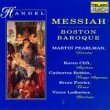About MessiahMessiah is aunique oratorio, for it is neither history nor dramatic tale nor philosophy. All of its text is scripture, from both Old and New Testaments, selected and sequenced by Charles Jennens, a librettist with whom Handel had collaborated previously. Its subject is the Anointed One, the Expected One, the promised royal and spiritual leader of the Jewish people. A peculiar feature of the texts which Jennens selected, however, is that in only one instance is the name Jesus cited, and that is very near the end of the oratorio. This opens the oratorio to a new role: a reflection or contemplation of the nature of the Anointed One rather than a celebration of a particular named figure. It is the abstraction of Messiah’s text that may in the long run have made it possible for Handel to offer this oratorio during Lent in a secular setting–a theater in Dublin–to raise money for several charitable institutions. Even so, Jonathan Swift, the Dean of St. Patrick’s Cathedral in Dublin, considered the performance of sacred text outside a sacred setting so abominable that he published a notice forbidding any church related person to participate in any way, or even attend any performance of the work, on pain of punishment by the church1. Swift must have relented in the end, though, because singers from the cathedral choirs appeared in the premiere performance on April 13, 1742. Messiah continued to be a favorite in Handel’s time. Different performances in different locations required the composer to prepare new arias or recast some of the existing music for different singers with different voice ranges. None of these changes dampened the public’s enthusiasm for the work. In fact, if anything, Messiah transcended its time so successfully that composers like Mozart and any number of conductors adapted it for performances in their own day. It’s safe to say that Handel would barely recognize his work in some of those adaptations: ponderous tempos that accommodated a chorus of a thousand singers; massive reorchestrations for large ensembles of modern instruments; wholly un-baroque performance style for the singers and the instrumentalists; and of course no consistent pattern for the choice of arias and choruses. Yet in spite of how musicians and adoring fans have encountered it over the centuries, Messiah remains vitally alive in the music scene and the consciousness of our culture today. I think the key to Messiah’s perennial appeal lies in Handel’s genius at communicating meaning through his music. A devout man, he felt he was divinely inspired and even saw God when setting the text. His upbringing in a strongly Lutheran family in the Saxon city of Halle, the center of Pietistic reform, and his attendance at Halle University as a seventeen-year-old, while its Pietist founder August Hermann Francke was fully active there, may well have made it possible for him to experience the Hertzensreligion (religion in the heart), sensitizing him to the emotional power of the Bible.2 However, promulgation of religious dogma was evidently not his aim in composing Messiah. Rather, he saw beyond the surface of the texts which Jennens selected to the human experience conveyed in them. The texts create a framework of topically related events which Handel’s music clothes in an aural analogy of peace, hope, joy, confusion, confidence, suffering, and triumph. How can we perceive Handel’s “language” more clearly today or enhance our encounter with the rich images he brought to this oratorio? Perhaps we will benefit from a short walk alongside the music, as if in a nature reserve, examining some details as they occur in the work. We will be dealing with compositional devices such as word painting, walking bass, counterpoint and homophony, hammer strokes, dance idioms, uses of harmony and chromaticism, as well as baroque conventions of fugue, recitative, aria (here called “air”), and chorus. (The definitions for these terms can be accessed quickly if desired in the course of this essay so the flow of the discussion will not be interrupted.) These devices were common coin for Baroque-era composers, who saw their art as an extension of spoken rhetoric and used certain conventions to convey meaning in music (the so-called “doctrine of affects”) and move the emotions of the audience. These details are usually lost on listeners today. Our consideration of Handel’s music will explore some of these details to reconfigure our imagination to his “language” and hear his “take” on the text of Part I, the so-called Christmas portion, and the “Hallelujah” chorus. There will be references to the critical score published by the Georg-Friedrich-Händel-Gesellschaft, Bärenreiter, Kassel, 1965. The musical excerpts are from the 1992 recording by the Boston Baroque Orchestra and Chorus, directed by Martin Pearlman (Telarc CD-80322).
PAGE 1 2 3 4 5 6 7 8 9 10 11 12 13 1 “Messiah.” www.stpatrickscathedral.ie/handel’s.htm, n.d 2Jennifer Payne, “Halle Pietism: Religious Compromise and Prussian Social Transformation,” htte://www.geocities.com/Athens/Aegean/7023/pietism.html?200516, August 1998 revision. An interesting essay on the religious environment in 17th-century Halle. |

